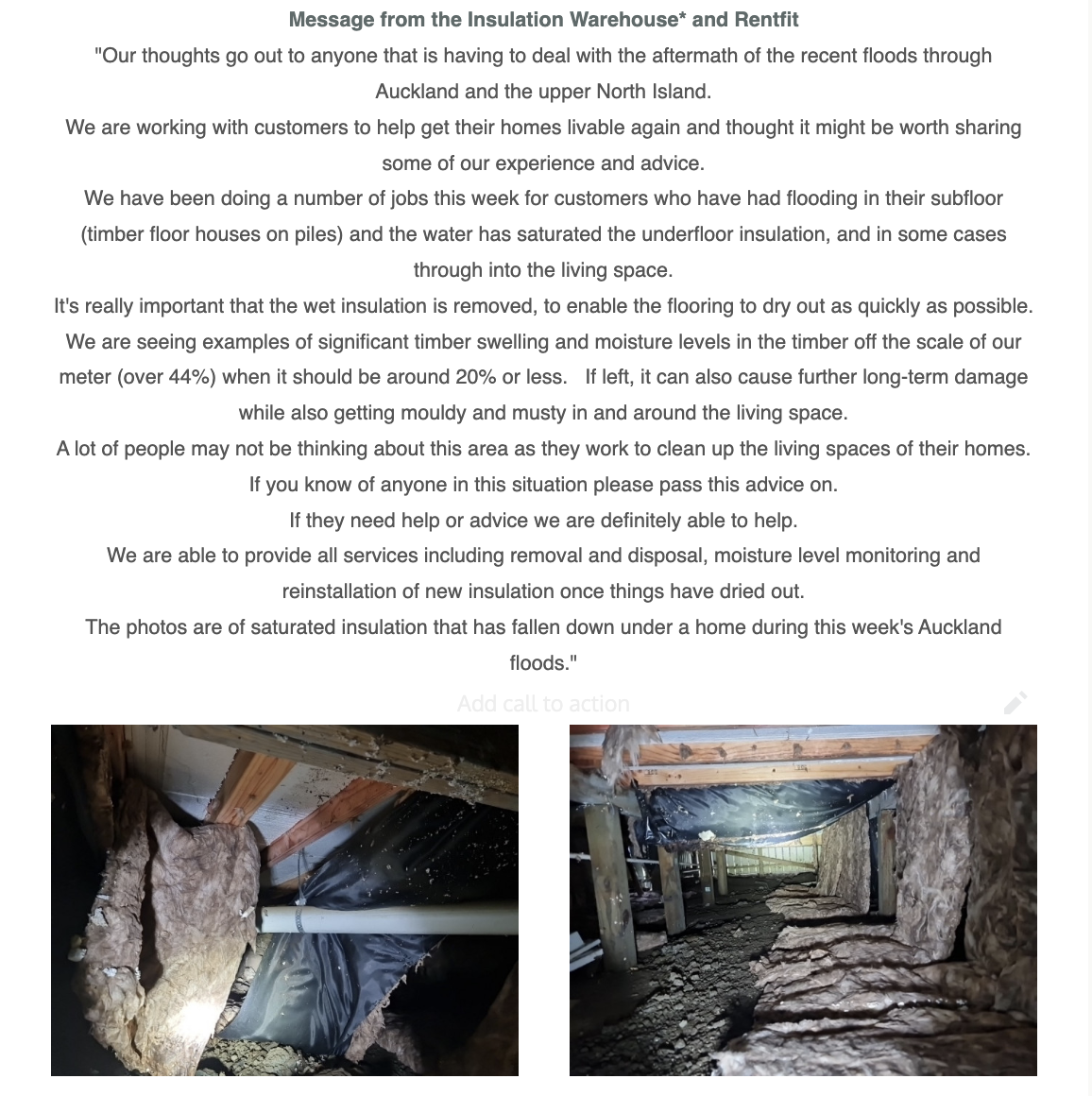Our thoughts go out to those affected by the anniversary weekend floods. Flood remediation and tenancy reinstatement can be long and arduous for many in the rental sector and we remain committed to supporting our members and their tenants throughout and in the aftermath of this weather event.
This FAQ reflects the most commonly asked questions we received from landlords and tenants this week. It has been edited so as not to regurgitate information that is already abundantly available on sites such as:
- Tenancy Services: Repairs after a natural disaster
- Initio Insurance: Anniversary weekend floods insurance tips and FAQs
- IRD: Flooding in the North lsland, meeting your tax obligations
- Initio Insurance: Is yours a sudden or hidden gradual water damage?
- Auckland Emergency Management
- WINZ: Support for those affected by the North Island floods
We urge everyone to familiarise themselves with the (updated) content on these sites.
Q. Is there a requirement to abate rent?
Yes. S59 of the Residential Tenancies Act requires rent to be abated accordingly if the property is destroyed or seriously damaged to the extent that it has become wholly or partially uninhabitable. If despite the destruction/damage, your tenant still wants to pay the full rent then that is their prerogative; there should be no suggestion, innuendo, coercion or pressure for them to do so.
Q. How much should I abate the rent and how long for?
Rent should be abated at least for as long as it takes to remediate the property to habitable standards. As to how much rent should abate by, there is no hard and fast rule. Consider to what extent (on a % basis) the destruction/damage diminished the tenant’s use and enjoyment of the property. For example, a half-size bedroom being used as an office that has become uninhabitable should, we imagine, warrant less abatement than a bedroom under similar circumstances. Consider also your tenant’s personal circumstances as well as the history, nature and your intention for the tenancy in question. Use these metrics as a starting point to negotiate a reasonable abatement plan with your tenant. Always remember to be kind as the tenant is likely and rightfully distressed.
Q. What if my tenant and I cannot agree on how much to abate rent by?
Apply to the Tenancy Tribunal or Tenancy Services’ FastTrack Resolution (especially in straightforward abatement disagreements) for a determination. In the meantime, we strongly recommend all landlords and tenants in this situation keep a detailed ledger documenting rent in advance, undisputed rent, disputed rent etc.
Q. Can I claim the abated amount from my loss of rent cover?
It really depends on your individual circumstances and the terms of your policy. Please contact your insurer for clarification.
Q. What makes a property ‘uninhabitable’?
Ah. And therein lies the rub. Assume that any building that has been red or yellow sticker would, more likely than not, be at least partially uninhabitable. In saying that, white stickers do not represent an all clear vis-à-vis s59. Watch this video to learn more.
Q. My tenant is unable to fulfil his/her obligation under a Termination Order to move out due to the flood. Would granting a short period of reprieve prejudice my rights under that Order?
In general, no. The tenancy is terminated per the order and the tenant is merely remaining in possession without an underlying tenancy. Be careful not to fall into a new periodic tenancy on account of s60 of the RTA (unless that is what you want). More on that here.
Good on you for considering the well-being and safety of an outgoing tenant. The conservative approach would be to clearly communicate and document (ideally signed by all involved) the intent behind the extended occupation which is to accommodate the extraordinary circumstances of the floods and support the tenant through a tough transition period and that the tenant would vacate the property as soon as it is practicable and safe to do so.
Q. My tenant gave notice to terminate before the floods and now wants to stay. What should we do?
Your tenant’s notice can be revoked under s51(6) of the Residential Tenancies Act but it has to be with your consent. If you are in a position to and are inclined to let your tenant stay on (such as if the property hasn’t already been rented out to someone else) please do, it’s a tough time for a lot of tenants at the moment.
Q. I have submitted an insurance claim, how long should I expect to wait before hearing back from my insurer?
It really depends on your individual circumstances as well as your insurer’s internal triage. We understand that additional assessors are coming in from Australia to support the insurance industry’s response to the floods. Watch this video to learn more.
Q. My tenant would not let me use their power outlet for my blower/dehumidifier, what do I do?
Roll out your own generator if you have to given that flood remediation falls on the landlord. Chances are, your tenant is concerned about his/her power bill. That’s understandable. Assuring them that they will be reimbursed for your use of their power (and actually reimbursing them) should be sufficient to take that concern off the table.
Q. The flood has destroyed/damaged various HHS features at the property. The property is technically in breach, what should I do?
Make sure you have clear documentation on efforts on your part to assess and remediate the damage(s) to HHS features including records of inspection, communication with tenants, engagement of tradespeople, quotes/invoices etc. We have reached out to Tenancy Services and its Compliance and Investigations Team for their guidance and assurance that it would take the floods into consideration should your property be assessed/investigated.
Speaking of damages to HHS features, owners of properties with wet insulation should note the following from The Insulation Warehouse*:

Q. There is evidence of flooding under the house. Apart from pulling out the insulation, what else should I be doing?
- Check that the ground moisture barrier is still intact and undamaged. So long as the water has been drained off the moisture barrier, it should continue to do its job of stopping moisture from rising in the house. There may be some circumstances where the ground moisture barrier is dislodged and requires repair and/or becomes contaminated and needs to be replaced. Our friends at RentFit have removed 9% of the ground moisture barriers inspected so far.
- Air or dry out the subfloor cavity until the moisture level reads less than 20% before you re-install insulation.
- Make sure all belongings (yours and your tenant’s) are removed, dried out and remain outside the cavity until the moisture level is back down to below 20%.
Q. My tenant has been displaced by the floods but has nowhere to go and all the emergency accommodations are filled up. What can I do?
First, ask yourself why you are rehousing your tenant. If you are doing this out of your own sense of decency then that’s great and we applaud you. But if you are doing this because you think you are obligated to then we suggest that you check your insurance policy to ascertain the obligation as most landlord insurance does not contain a provision requiring landlords to rehouse tenants displaced by natural disasters.
Lodge your details with us and we will do a private callout within our network to see if any landlord has properties that can accommodate your tenant. Similarly, get in touch if you are in a fortunate position to house displaced tenants at one of your properties. There are some caveats and legal considerations involved but we can go through those with you.
Alternatively, consider pre-built transportable housing solutions in appropriate circumstances. Keith Hay Homes* is one such provider and we can support you by facilitating an introduction and supplying you with more information.
Q. I was planning to give a termination notice before the floods hit. Can I still do that?
Always consider your tenants’ situation especially if they have been adversely affected by the floods. If you can afford to hold off, hold off. Be careful that your notice does not wind up being ‘retaliatory’ under s54 of the RTA. The maximum penalty is $6,500. You definitely don’t want to go there. If you have been contemplating a termination and have not yet notified the tenant, watch this video to brush up on your s54 knowledge.
Bookmark this page and check back regularly as we will continue to add to this FAQ as the questions come in.
*The Insulation Warehouse and Keith Hay Homes are both sponsors of ours.
















Add Comment